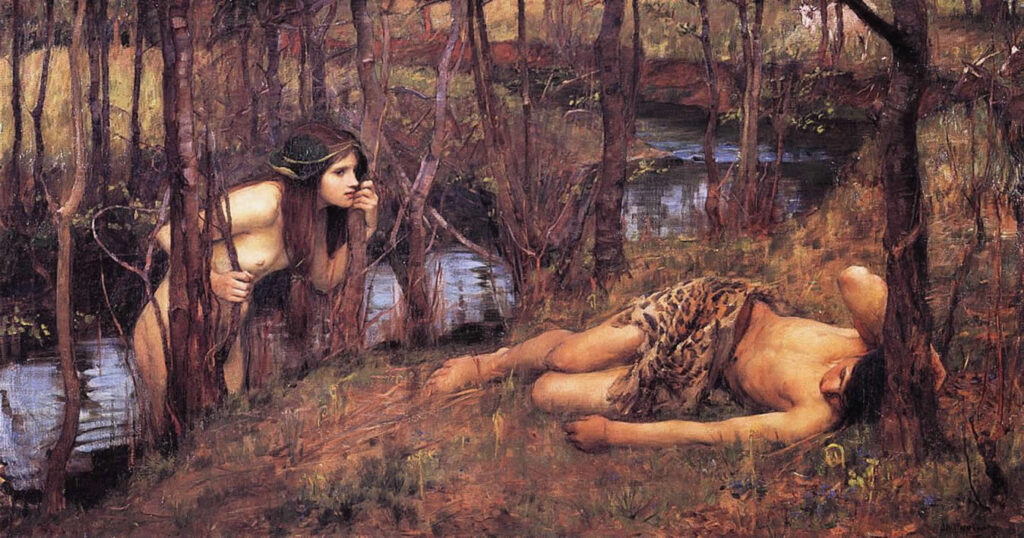
A Freshwater nymph that lives along with springs, holy wells, rivers, waterfalls, and fountains is known to be a guardian of the waters in her domain. Depicted as an attractive nude bathing woman, they are known to entice and lure men to their waters. Sometimes, this is too seductive folly, a love affair, or a dangerous end. Derived from the Greek word Ναϊάς, or Naiás, meaning “to flow” or “running water”.
The Naiad is a female water nymph or spirit that guards over wells, springs, streams, brooks, fountains, and freshwater pools or lakes. Some say the Undine is the saltwater variant, while the Naiad is the freshwater variant. They are not to be confused with River God/desses who embody rivers or inhabit still waters of ponds, lagoons, lakes, and marshes such as the pre-Mycenaean Lerna described in the Argolid.
They belong to Greek mythology but have spread throughout the European worldview. Although they are most believed to be associated with freshwater, since the Greeks believed that all of the world’s waters were one, flowing through a cavernous aquifer and inter-connected, they could be in more than one place at the same time. This is also their explanation in relation to Oceanids, Nereids, Undines, and Mer-folk. In the Greek myths about Arethusa, a water nymph of a spring, that could make her way from Peloponnesus to surface on the island of Sicily.
They were worshiped by water cults who often made offerings into the waters or along its edges with such things as bins, coins, cloth, clothes, sandals, jewelry, treasures, figurines, flowers, and/or sacrificed animals to the waters in hopes the Naiads would bring them healing, inspiration, gifts, magic, blessings, or passage. In some practices, boys and girls who were coming of age would dedicate their childish locks to the local Naiad of the spring. In Lerna, ritual cleansings utilized the magical waters from the Naiad’s spring or well that were believed to possess certain healing or medicinal properties.
In ancient Mythology, Hylas of the Argo’s crew was lost when he was captivated by Naiads, who were in awe of his beauty. They are known to be jealous fae folk – as in Theocritus’ tale of a Naiad’s jealousy when the Naiad Nomia or Echenais, who was in love with Daphnis, the Shepherd. He was unfaithful to her on numerous accounts, and she blinded him out of revenge. Hermaphroditus was forced into sex with the Naiad Salmacis, and when he sought to escape her, she fused with him, giving birth to hermaphrodites. In the mythos of Aristaeus, The Naiad Chlidanope marries Hypseus, the King of the Lapiths, and gives birth to Cyrene. Aristaeus also consulted the Naiads when his bees died, and his aunt Arethusa invited him below the water’s surface, where he was washed with the waters from a perpetual spring and given his advice. Throughout Europe, magical springs and holy wells were at first attributed to various Deities and/or water nymphs before they were converted to wells and springs associated with Saints. It was a very common practice in Celtic cultures.
Related to Undines, Oceanids (saltwater), Nereids (Mediterranean), Water Nymphs, Mermaids, and Mermen.
Written, researched, and Copyrighted (© 2013) by Leaf McGowan, Thomas Baurley, Techno Tink Media
Bibliography, References, and Recommended Reading:
- Burkert, Walter 1985 “Greek Religion”. Harvard University Press.
- Graves, Robert 1955 “The Greek Myths”.
- Homer “Odyssey” and “Iliad”
- Poe, Edgar Allen 1829 “Sonnet to Science”.
- Silver, Carole B. Silver “Strange and Secret Peoples: Fairies and Victorian Consciousness”. ISBN 0-19-512199-6.
- Wikipedia: The Free Encyclopedia. undated “Naiads”, “Undines”. Web site referenced on March 8, 2014.

One thought on “Naiads”